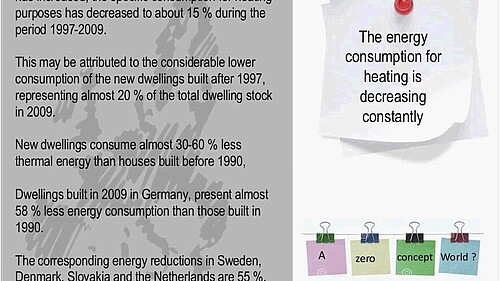Webinars
1st Webinar: The concept of Smart Buildings and the Integrated Design organised by University of Athens
The first webinar of the Smart GEMS project took place on 21st of October 2015. The objective of the webinar was to underline the principles of ID procedure and link the process with smart building technologies. The presentation by UoA included among other issues such as:
- The Integrated Design step by step process from initial concept to in-use phase of a building
- Current policy framework in EU to promote ID as supportive tool for NZEB
- Smart building technologies to achieve high energy performance and sustainability
- Development of a collaborative methodology to incorporate energy management and smart building technologies to the ID concept.
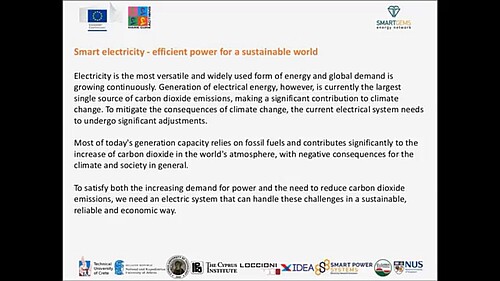
2nd Webinar: The Concept of Zero Energy Building organised by Technical University of Crete
In the second webinar which took place on the 11th of November the main objectives were to underline the main definitions of Zero Energy Buildings and to provide an overview of the technical and non-technical aspects for ZEB development in the EU. The webinar included an overview of the following:
- The ZERO Energy Buildings Definitions, various approaches and methodologies
- EU and International legislation, trends and perspectives
- Energy efficiency and climatic diversity
- The role of energy management, smart metering and demand response
- The role of the building users
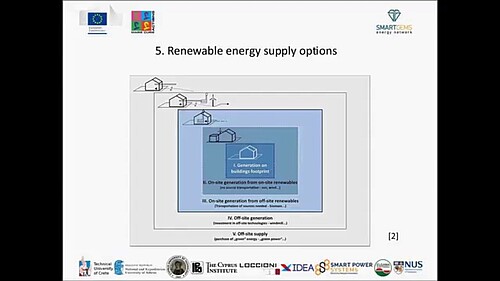
3rd Webinar: Training in Smart and Zero Energy Buildings by Cyprus Institute & nZEB Case studies organised by Cyprus University of Technology
In the first session of the webinar the main focus was to illustrate the design principles of the near zero energy building which belongs to the CyI called the “Novel Technologies Laboratory Building” (NTL). The particular building was selected to be examined and presented as a state-of-the-art infrastructure and among the very few available in the wider area of the Eastern Mediterranean.
In the second session hosted by Cyprus University of Technology, a case study of energy efficiency refurbishment towards Near Zero Energy Houses was presented including various refurbishment measures such as:
- Placement of insulation on the roof and the walls
- Installment of horizontal overhangs in the south facing windows
- Replacement of the split units with energy class A+++
- Installation of PV system on the roof.
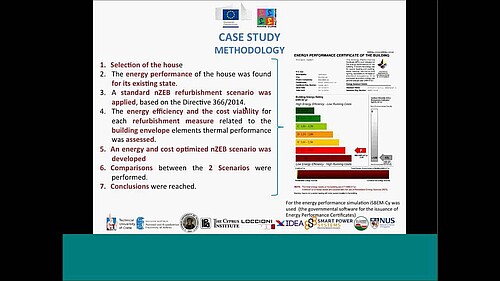
4th Webinar: Two case studies of smart ZEB: the LEAF House & the LEAF Lab organised by AEA / Loccioni Group
The Leaf House and Leaf Lab were presented as they constitute a best practice Smart Residential Building and the first connective industrial building in EU respectively. The structural and operational facilities of both buildings were highlighted. The Leaf House is south oriented with a very low U-value building envelope with solar tubes for lighting comprising 6 apartments. Systems installed include 20kW PV with 5.8kWh electric storage, solar thermal panels, rain water collecting and treatment system, geothermal heat pumps, hot water storage and air handling unit with natural preconditioning. The Leaf House is an open laboratory with the following types of sensors:
- indoor comfort (temperature, humidity, CO2)
- thermal and electrical measures
- energy consumption
- rain water level
Building controls in the Leaf House apartments consist of touch screens allowing tenants to adjust the desired temperature, switch lights, monitor energy consumption, check if windows and doors are open etc.
The Leaf Lab is a high-performance productive building constructed to be in harmony with the surrounding environment. Architectural and engineering design parameters allow for comfort of people while working and low management costs. The initial investment was just about 20% higher compared to conventional industrial constructions. The Leaf Lab has a total area of 6000 m2 and annual energy consumption of just 4kWh/m3. It is independent of natural gas and classified as A+ with regards to its energy efficiency. Systems installed comprise a rooftop PV 235kWp, electric and thermal storage systems, free and natural cooling systems, ground water pumps, advanced lighting systems etc. All systems are integrated and controlled through “MyLeaf: a proprietary Building Energy Management System created by AEA / Loccioni Group.
5th Webinar: The ZEB buildings technology market organised by IDEA
The 5th webinar in the context of the Smart GEMS project involved the main technologies for energy harvesting, storage and conversion in ZEB together with their maturity level and market perspective. Various technologies along with key technology market issues such as downscaling, flexibility, integration and cost in the following categories were presented:
- Solar thermal collectors
- Photovoltaic collectors
- Wind turbines
- Biomass digestors and burners
- Geothermal systems
- Microhydroelectric
- Micro cogenerators
- Fuel cell
- Energy conversion HVAC systems
- Intelligent Lighting
- Electric and Thermal Storage
- Control systems and smart appliances
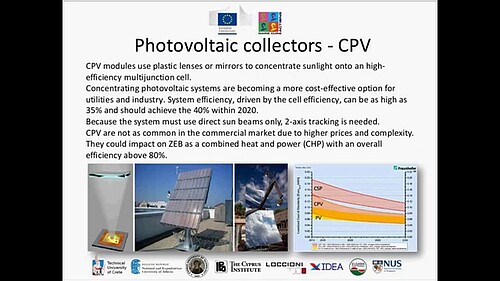
6th Webinar – Definition of Smart Grids organised by TUC
The main objective of the Definitions of Smart Grids Webinar, presented by TUC, was to introduce the fundamental principles of smart grids. Various definitions and different approaches were highlighted. EU policies, standards, benefits for key stakeholders, as well as advanced metering infrastructure and communication technologies were presented.
Webinar contents/structure:
· Introduction in Smart Grids
· Various definitions and classifications of Smart Grids
· EU policies for Smart Grids
· Smart Grid benefits and standards
· Smart Grids vs Microgrids
· Advanced Metering Infrastructure (AMI)
· Communication technologies in Smart Grids
· Perspectives and challenges in Smart Grids
· Best practices
· Conclusions
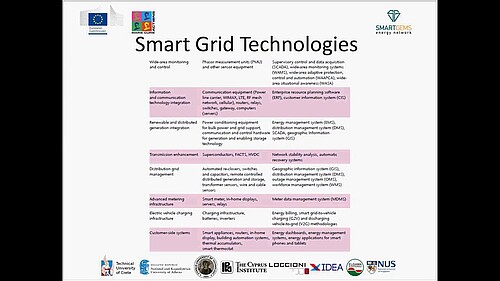
7th Webinar - Smart Communities organised by UoA and CyI
The main objective of the Smart Communities Webinar, presented by the UoA, was to underline the development of Smart and NZEB for Europe, analysing the major problems and setting a roadmap with involving future quantitative and qualitative targets. The methodology applied in this webinar is summarized in the steps described below:
· Presentation of The Development of Smart and NZEB protocols for Europe
· Objectives
o Analysis and identification of 3 major problems of the built environment
o Energy consumption
o Energy poverty
o Local climatic change
· Set of a roadmap involving future quantitative and qualitative targets, investigating the major technological, economic and social forces and policies
· What are the links, synergies, impacts and the interrelated nature and characteristics of the 3 sectors?
· Benefits for the society, including the impact on the economy, employment, the environment and health
· Conclusions

8th Webinar - Smart metering solution: systematic approach, flexible implementation organised by ELGAMA
The main objective of the Smart metering solution: systematic approach, flexible implementation Webinar, was presented by ELGAMA. The aim was to provide information about AMI architecture, basic principles, constituent devices, communication interfaces and state-of-art functionality. Solutions covering infrastructure from Central Systems (e.g. Meter Data Management Software MDMS) to Home Area Network (e.g. In-Home-Display) were illustrated. As the most critical element in such solutions, Smart Electricity meters are described in detail, pointing out advanced features and advanced employed technologies.
Webinar contents/ structure:
· Elgama Elektronika
· Smart metering pilot in Greece
· Advanced Metering Infrastructure (AMI)
o Main principles of AMI solution
· Elgama (smart metering) solution for domestic sector
· Open meter architectural model
· Open meter interfaces
· Functionality of AMI system
· Smart electricity meters
o Main features of GAMA 100/300
§ Advanced features of GAMA 100/300
o MI1: Meter – concentrator Interface
o MI2: Meter – AMI Central System Interface
o MI3: Meter – Local O&M device interface
o MI4: Meter – Multi-utility Meters Interface
o MI5: Meter – End of customer Device Interface
· Wireless M-Bus communication to In-home Displays
· Load Management
· Security
· Commissioning and inspection of meter
· SI 1/CI2: AMI Central System
· DC Key features
· Maintenance

9th Webinar – Smart Grids district heating/cooling and cogeneration organised by IDEA
The main objective of the fourth webinar was to present an overview about district heating and cooling (DHC), its link with cogeneration, the perspectives in terms of improved efficiency, integration with renewables sources and evolution in the smart cities framework.
District heating and cooling is an integrative technology that can contribute to reducing emissions of carbon dioxide, improving air quality in urban areas and to increasing energy security. The fundamental idea of DHC is connecting multiple thermal energy users through a piping network to optimized energy sources, such as combined heat and power (CHP), industrial waste heat and renewable energy generators. Some countries in northern regions, show a significant penetration of DHC, while it still represents only a small fraction of the total heat market of the European Union. Therefore the potential is large and varies in each country depending on past national policies. Integration of renewables, waste heat reuse, and lower operating temperature are the key issues in the present evolution of DHC, as well as the integration of more advanced IT management tools and the introduction of new business models.
District heating and cooling (DHC) is an integrative technology that can contribute to reducing emissions of carbon dioxide, improving air quality in urban areas and to increasing energy security. The fundamental idea of DHC is connecting multiple thermal energy users through a piping network to optimized energy sources, such as combined heat and power (CHP), industrial waste heat and renewable energy generators. Some countries in northern regions, show a significant penetration of DHC, while it still represents only a small fraction of the total heat market of the European Union. Therefore the potential is large and varies in each country depending on past national policies. Integration of renewables, waste heat reuse, and lower operating temperature are the key issues in the present evolution of DHC, as well as the integration of more advanced IT management tools and the introduction of new business models.District heating and cooling (DHC) is an integrative technology that can contribute to reducing emissions of carbon dioxide, improving air quality in urban areas and to increasing energy security. The fundamental idea of DHC is connecting multiple thermal energy users through a piping network to optimized energy sources, such as combined heat and power (CHP), industrial waste heat and renewable energy generators. Some countries in northern regions, show a significant penetration of DHC, while it still represents only a small fraction of the total heat market of the European Union. Therefore the potential is large and varies in each country depending on past national policies. Integration of renewables, waste heat reuse, and lower operating temperature are the key issues in the present evolution of DHC, as well as the integration of more advanced IT management tools and the introduction of new business models.
Webinar Contents/Structure:
- Definition of DHC
- Advantages of DHC
- Main components of DHC
- DHC in a smart city/community framework
- Solar hybridization of DHC
- Good practices
- Topics/activities for Smart GEMS participants

10th Webinar – LEAF Community and CAMP IT organised by AEA and TUC
First part: Seminar by AEA. The seminar described the materialised activities under the LEAF initiative/project at Loccioni.
Multiple Renewable Energy Sources (RESs), consumers, Electrical Energy Storage systems (ESSs), offices, industrial and residential buildings are all successfully integrated into the Leaf Community. Sun and water produce energy to such a smart community through micro-hydro power plants distributed along a river and PV rooftop installations located on top of each building; moreover, an energy storage system is integrated with buildings of various type (four industrial, one office and one residential) and electric vehicles and bicycles improve smart transportation. Additionally, measurements from the sensors and meters placed are collected via the web-based monitoring and control platform, developed by the Loccioni Group as well, called MyLeaf. Based on that data a dedicated control algorithms, implemented on the MyLeaf platform, efficiently coordinates all the energy systems by providing the optimal signals for production and charging/discharging strategy to all the energy sources in order to minimize energy costs and satisfy energy demand in real time. The health of our earth and of man is the main goal of the Leaf Community.
The contents of the presentation is as follows:
· Loccioni for Energy
· The LEAF Community
· THE LEAF Community and the IUndustrial Micro-grid
· Loccioni Microgrid 2012
· Loccioni Microgrid 2014
· MyLeaf
· MyLeaf: Energy Management System
· Loccioni Leaf Roof
· Loccioni Leaf Water
· Storage Systems
· Electric Vehicles
· Conclusions
11th Webinar -‘Innovation to Zero’ by UOA to the UK trainee participants of the MEnS project, 4 July 2016.
In this webinar, Theoni Carlessi (UoA) presented the Development of Smart and NZEB protocols for Europe. The structure of the presentation was a follows:
- Analysis and identification of 3 major problems of the built environment
- Energy consumption
- Energy poverty
- Local climatic change
- Set of a roadmap involving future quantitative and qualitative targets, investigating the major technological, economic and social forces and policies
- What are the links, synergies, impacts and the interrelated nature and characteristics of the 3 sectors?
- Benefits for the society, including the impact on the economy, employment, the environment and health
- Conclusions
